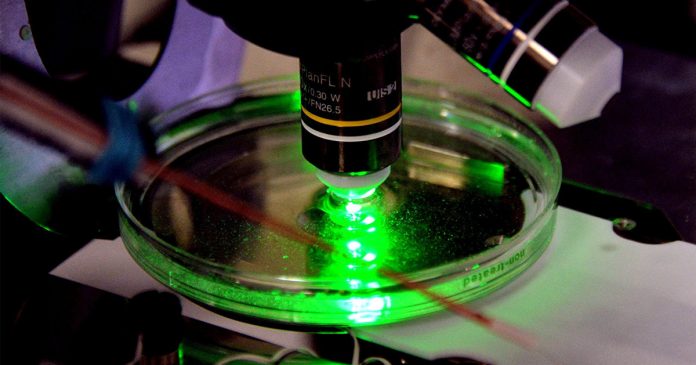
the First two million years life on Earth consisted of representatives of the two microbial kingdoms, bacteria and archaea. Within these kingdoms there was a rich diversity of species, however, in the end, by modern standards, life on Earth was not too impressive.
Then, if you believe the science, some unusual archaea swallowed a bacteria normal, resulting in a completely new kind of cells, which subsequently served as the basis for all complex life on Earth, from plants to people.
Today is the first time scientists have managed to grow archaea, which, in their opinion, similar to the ancestor of the first complex cells, called eukaryotes, and contains the core. The work of this group of scientists has been called “monumental” breakthrough, which casts light on the stage of evolution.
Nick lane (Nick Lane), Professor for evolutionary biochemistry at University College London, called the work “magnificent” and two other experts in this field noted that it represents “a huge breakthrough in Microbiology.”
Like bacteria, archaea continue to live on the Earth today. However, despite the key role that they, as scientists believe, has played in the emergence of complex life, they were devoted to relatively little research. Many species can be found only in the unfavorable habitats, and they are extremely difficult to grow in laboratory conditions.
a Team of Japanese scientists has devoted 12 years to conduct this study, and they had to face a lot of difficulties.
Their scientific Odyssey began in 2006, when they took samples of deep-sea ooze: while using the underwater camera they were able to take samples at a depth of 2.5 kilometers off the coast of Japan. These samples of deep-sea sludge was placed in bioreactorR, where they are constantly fed with methane for the past five years.
“most of the organisms grown in the laboratory conditions, multiply rapidly, are able to live in large populations and grow on their own, said Masaru Nobu (Nobu Masaru) from the National Institute of advanced industrial science and technology (National Institute of Advanced Industrial Science and Technology) in Japan. — The organism which we isolated, propagated 1000 times slower than E. coli, lives only in small groups, and its growth depends on the availability of symbiotic partners.”
Then Nobu and his colleagues took small samples from the reactor and placed them in glass tubes, where they stayed for approximately a year, before showing obvious signs of life. Scientists were trying to help them, feeding them nutrients, even gave them baby food. Cells required two to four weeks in order to reproduce by dividing, and this meant that each phase of the study lasted for months.
the Context Cells that are able to win лейкемиюLa Repubblica20.02.2016 How to resurrect marontate Conversation02.08.2013 Blood and living cells detected in the carcass of a mammoth?Scientific American04.06.While 2013 was the study, a team of scientists from the Netherlands, also studied archaea, made an accidental discovery. They sequenced the DNA of microbes extracted from samples that were taken in the hydrothermal source off the coast of Greenland. One gene was different from the rest: he, undoubtedly, belonged to bacteria, but his DNA contained genes similar to those the researchers observed in the ECkriticheskih cells.
Cells that are able to win лейкемиюLa Repubblica20.02.2016 How to resurrect marontate Conversation02.08.2013 Blood and living cells detected in the carcass of a mammoth?Scientific American04.06.While 2013 was the study, a team of scientists from the Netherlands, also studied archaea, made an accidental discovery. They sequenced the DNA of microbes extracted from samples that were taken in the hydrothermal source off the coast of Greenland. One gene was different from the rest: he, undoubtedly, belonged to bacteria, but his DNA contained genes similar to those the researchers observed in the ECkriticheskih cells.
the Scientists called them archaea Asgard and hypothesized that the ancestors of this branch of evolution could fill the gap between primitive and complex life forms for a few million years earlier.
When Japanese scientists sequenced their samples, genetic analysis showed that they were able to grow the Archean Asgard. Previously, scientists have found that it is this genetic code, but they didn’t know how this body looked like.
a Study by Japanese scientists has shown that archaea Asgard is a small, simple cells and they have long, similar to antennae of education. Not all agree that these archaea are the ancestors of complex life. But the proponents of this theory believe that one of these cells could engulf a bacterium, whereupon the bacterium became the mitochondria that today acts as an internal power source within the complex cells. Bacteria and archaea have no mitochondria.
Japanese scientists have suggested that using their antennae Archean Asgard could hook near the bacterium and form with it a symbiotic relationship. As a result of several evolutionary leaps, these two organisms merged into one more complex type of cell — a primitive eukaryotic cell.
This scenario still remains a hypothesis that will be discussed during the next 10 years. In any case, this breakthrough, most likely, will push for the resumption of these poorly studied microbes.
“it’s Hard to describe the significance of this research, lane said. — You see these genomic sequences and trying to reconstruct how he could look like a cage like this, but this is only conjecture. But finally we saw the looks of this cage, and it’s not like everyone was expecting”.
the new York times Materials contain assessment exclusively by the foreign media and do not represent the position of the editorial Board of the new York times.
















